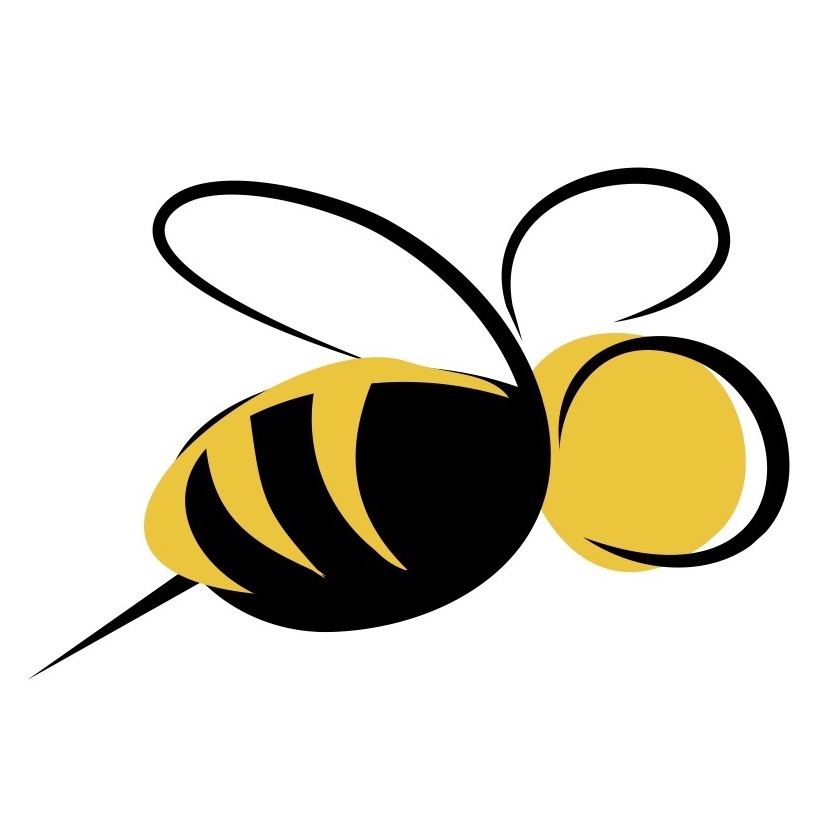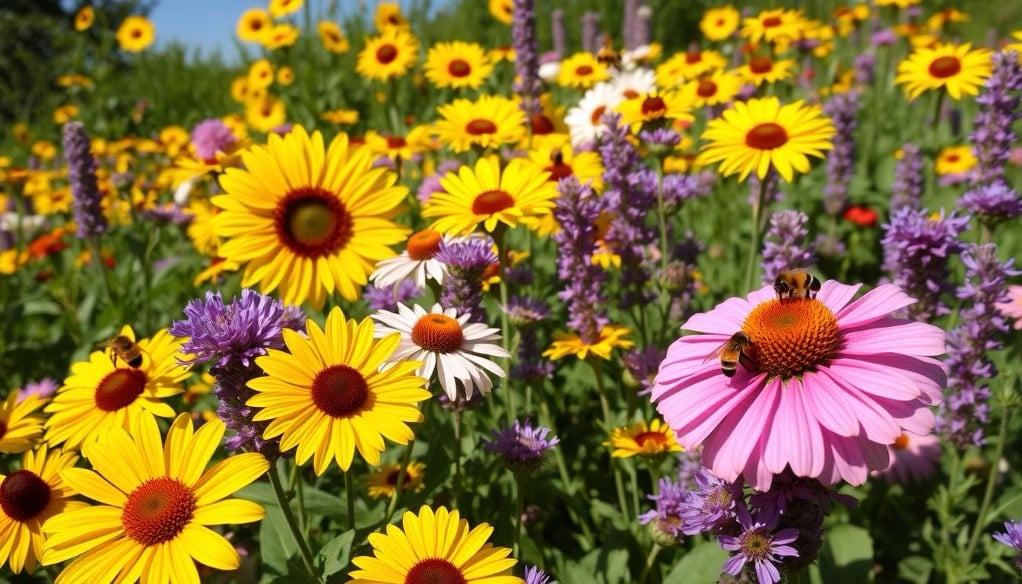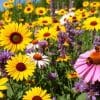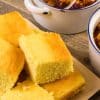When searching for the best flowers to plant for bees and butterflies…
Keep in mind that the best flowers have bright colors and easy access, but they also need to provide ample nectar and pollen.
Here are some suggestions that fit the bill to support these important pollinators:
Perennials (These Return Every Year)
Lavender (Lavandula) – Bees love its strong scent, and butterflies are drawn to its nectar.
Echinacea (Coneflower) – A long-lasting bloom that provides nectar for butterflies and pollen for bees.
Bee Balm (Monarda) – A magnet for both bees and butterflies, with bright red, pink, and purple flowers.
Black-Eyed Susan (Rudbeckia) – A favorite for many pollinators, providing nectar in summer and seeds for birds in fall.
Salvia (Sage) – Comes in many varieties and is irresistible to bees and butterflies.
Yarrow (Achillea) – Flat-topped clusters are easy for butterflies to land on and gather nectar.
Milkweed (Asclepias) – Essential for monarch butterflies, as it serves as a host plant for their caterpillars.
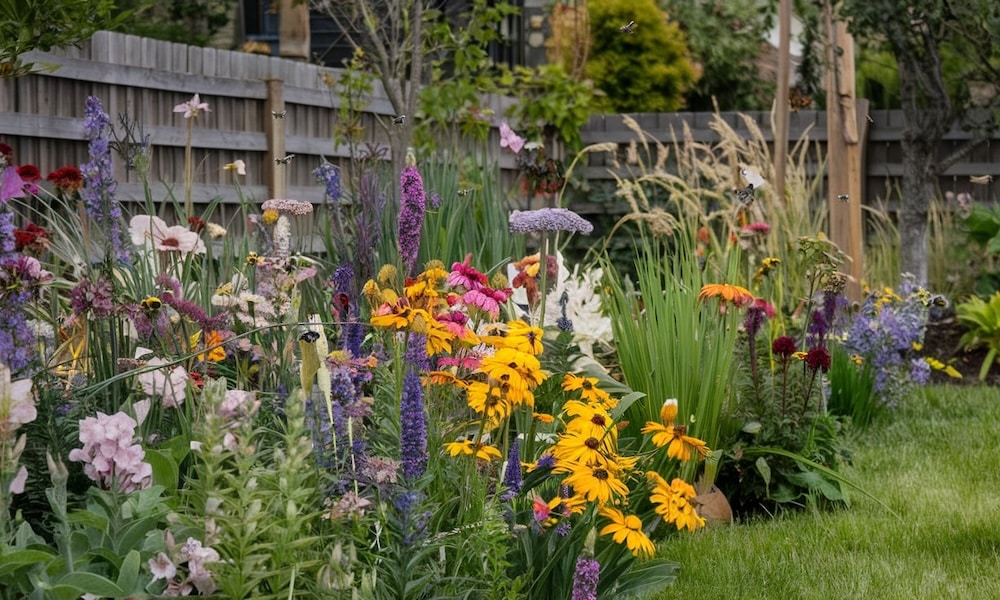
Annuals (These Need to Be Replanted Every Year)
Zinnias – Butterflies especially love these easy-to-grow, bright-colored flowers.
Cosmos – A favorite of bees and butterflies, with long-lasting blooms.
Sunflowers (Helianthus) – Offer nectar for pollinators and seeds for birds later in the season.
Marigolds – Attract butterflies and deter pests in your garden.
Flowering Herbs
Thyme – Small flowers loved by bees.
Oregano – A favorite among honeybees.
Basil (When Allowed to Flower) – Produces nectar-rich flowers.
Mint – Pollinators love the blossoms, but mint can spread aggressively.
Rosemary – Provides nectar in early spring.
Shrubs & Vines
Butterfly Bush (Buddleia) – True to its name, this shrub attracts tons of butterflies.
Lantana – A long-blooming shrub that draws in both bees and butterflies.
Honeysuckle (Lonicera) – A vine that produces sweet, nectar-rich flowers.
Lilac (Syringa) – Offers fragrant springtime blooms loved by butterflies.
Tips for a Pollinator-Friendly Garden
Choose native plants – Local pollinators prefer native flowers.
Plant a variety of flowers – Different shapes, colors, and bloom times ensure a steady food supply.
Avoid pesticides – Many insecticides harm pollinators, even if they’re labeled as organic.
Provide water sources – A shallow dish with stones can help butterflies and bees drink safely.
Pollinator-Friendly Garden Layout Plan
Here are some key elements to keep in mind:
Layered Heights – Tall plants in the back, medium-height plants in the middle, and low-growing flowers in the front.
Continuous Blooming – Selecting plants that bloom at different times ensures nectar availability throughout the seasons.
Color Variety – Bees love blue, purple, and yellow; butterflies prefer red, pink, orange, and purple.
Water & Shelter – A small dish with stones for water and some sheltered areas for resting.
Garden Layout Advice
Create a layered look with tall plants like sunflowers and a butterfly bush at the back, medium-height plants like echinacea and black-eyed Susan in the middle, and low-growers like lavender at the front. This arrangement ensures each plant gets enough light and adds an aesthetically pleasing tiered effect to your garden.
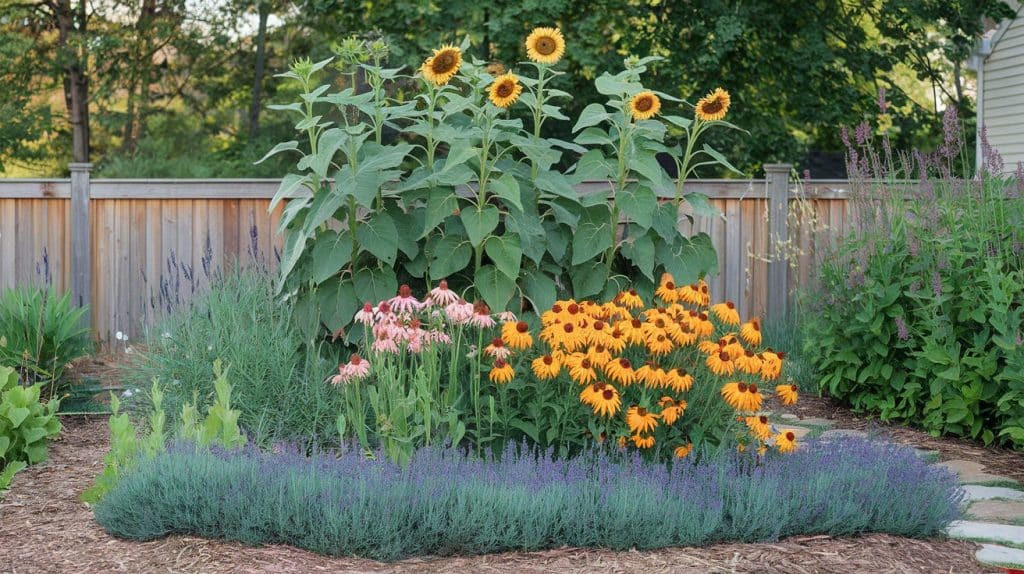
Back Row (Tall Plants – 3-5 ft+) (North Side for Sun Lovers)
Butterfly Bush (Buddleia) – Blooms summer to fall, attracts butterflies & bees.
Milkweed (Asclepias) – Essential for monarchs, hosts caterpillars.
Sunflowers (Helianthus) – Provides nectar for bees and later seeds for birds.
Joe-Pye Weed (Eutrochium purpureum) – A butterfly magnet with tall pink blooms.
Middle Row (Medium-Height Plants – 1-3 ft)
Echinacea (Coneflower) – Summer-long nectar source, great for bees & butterflies.
Black-Eyed Susan (Rudbeckia) – Long bloom season, loved by pollinators.
Bee Balm (Monarda) – Red and purple varieties attract hummingbirds too.
Lantana – Heat-tolerant shrub that provides nectar from summer to frost.
Yarrow (Achillea) – Flat-topped flowers make easy landing spots for butterflies.
Front Row (Low-Growing Flowers & Herbs – Under 1 ft)
Lavender (Lavandula) – Provides nectar and repels pests.
Thyme & Oregano – Flowers attract bees, plus they’re useful in cooking.
Marigolds – Add vibrant color and deter pests naturally.
Zinnias & Cosmos – Perfect for butterflies, easy to grow and re-seed.
Bonus Features for a Pollinator Oasis
Puddling Station for Drinks and Rest
Place a shallow dish with wet sand and stones in your garden so bees and butterflies can land and drink.
Bee-Friendly Shelters
Bee hotels made of hollow bamboo or drilled logs for solitary bees.
Leaf piles and undisturbed ground areas for nesting.
Sunny Spots
Butterflies need the sun to warm up before they fly. Add a few flat rocks to help them bask.
Pollinator Protection
To keep your garden a true refuge for pollinators, opt for natural pest control methods and avoid pesticides, which can harm these beneficial insects. By planting a mix of annuals, perennials, and herbs, and providing water and shelter, you can create a thriving habitat that supports the local ecosystem and brings your garden to life.
I hope this helped. Wishing you the best blooms and the busiest bees!
Views: 25
